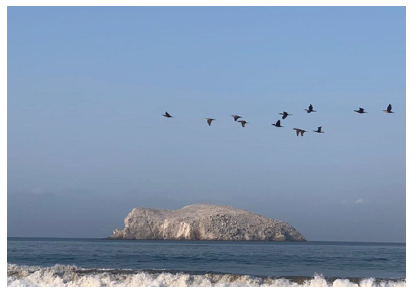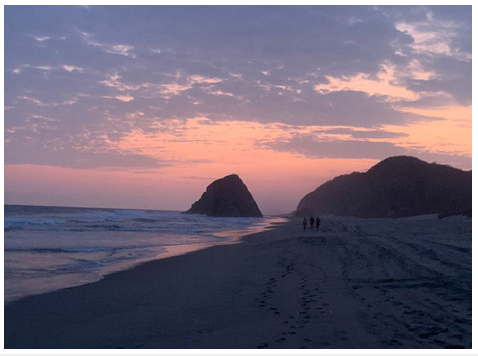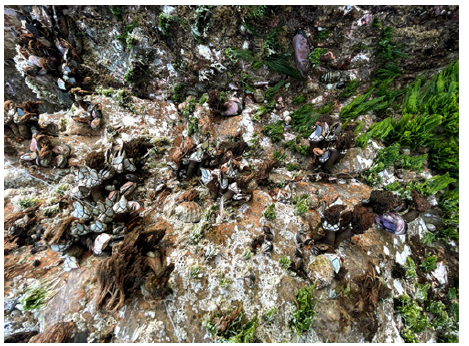- Submissions

Full Text
Examines in Marine Biology & Oceanography
The Marine Coastal Scenic Landscape as an Input for the Socio-Environmental Conservation of Coastal Marine Environments: The Case of Playa Peña Blanca, Mexico”
Omar Cervantes1*, Sosa-Argáez I3, Olivos-Ortiz A2, Silvestre-Campos A3 And Verduzco-Zapata G1
1Facultad de Ciencias Marinas, Universidad de Colima, México
2Centro Universitario de Investigaciones Oceanológicas, Universidad de Colima, México
3Facultad de Turismo y Gastronomía, Universidad de Colima, México
*Corresponding author: Omar Cervantes, Facultad de Ciencias Marinas, Universidad de Colima, Manzanillo, México Email: omar_cervantes@ucol.mx
Submission: February 06, 2023;Published: February 09, 2023

ISSN 2578-031X Volume5 Issue3
Introduction
The Peña Blanca beach is located on the Pacific coast in the state of Colima, Mexico. Its unique features include sand dunes, beaches, coastal lagoons, wetlands, cliffs, tidal pools, low deciduous forest, mangrove forest, and dune vegetation [1] that is influenced by two climatic seasons, dry and wet, the latter associated with hurricanes and tropical storms [2]. These seasons influence oceanographic conditions that, together with the tides and waves, foster coastal currents that affect the physicochemical characteristics and distribution of water masses. In turn, these are associated with the distribution of species such as marine mammals and coastal birds in the central Pacific of Mexico [3,4]. As a whole, these environments comprise a unique complex socio-environmental system that is under a dynamic equilibrium where the interaction of the coastal marine biophysical elements provide a series of goods and services, including a first line of defense against a latent rise in sea level along with multiple socio-cultural and gastronomic inputs, natural richness, and emerging services. These comprise the coastal beach + dune landscape [5], whose value lies in attributes such as the sea, sand, vegetation, its colors and textures, and the conditions of sea water and its coastal marine biodiversity components (Figure 1. Photo Omar Cervantes).
Figure 1:Coastal landscape in Playa Peña Blanca, Island and birds. Manzanillo, México.

In the latter, it is worth highlighting the presence of 3 species of sea turtles (Lepidochelys olivacea [olive ridley sea turtle]; Chelonia Agassizii [Pacific green turtle] and Dermochelys coriacea [leatherback sea turtle]; [6] marine mammals (Steno bredanensis [rough-toothed dolphin] and Megaptera novaeangliae [humpback whale]; [3], and coastal birds such as Phaethon aethereus (redbilled tropicbird [4]) (Figure 2. Photo Omar Cervantes). These areas are also home to other edible plant and animal species, including polyplacophorans (Chiton articulatus, sea cockroach), maxilopoda (Pollicites elegans, barnacles), bivalve mollusks (Choromytilus palliopunctatus, mussels) and gastropods (Calyptraea spirata, slipper limpet) [7] and plants such as organ pipe cactus (Stenocereus thurberi), lechuguilla (Agave lechuguilla), prickly-pear cacti (Opuntia ficus-indica and Opuntia dilleni), mesquite (Prosopis juliflora), and Parota tree seeds (Enterolubium cyclocarpum) [6]. All these biotic components, together with the landscape attributes of the territory, are combined in a marine coastal scenic and gastronomic landscape, understood as the intrinsic association between nature and man through culture and knowledge transformed to create flavors, colors, and textures, that result in an identity intrinsically linked to the beach. A clear example of the nature-society-culture interplay, which evidences the historical recollection and its inherited traditions passed across generations and which remains in the taste of the local community as a marine coastal marine scenic landscape and regional food heritage, is represented by the ordinary dishes that differ from one place to another [8] (Figure 3. Photo Itzel Sosa-Argáez).
Figure 2:Sunset at Playa Peña Blanca, cliffs, dunes and beach. Manzanillo, México.

Figure 3:Coastal marine landscape.

For instance, the preparation of seasonal and/or harvesting dishes historically consumed by coastal communities, creating particular versions of sea-spoon ceviche, seafood salads to which limpet meat is added, and pitahaya-based jams and preserves, which are part of the traditional regional cuisine of the coast. This phenomenon ranges far beyond the artistic objects, historical spaces, and landscapes of a territory; it also embodies the living, immaterial, popular culture, reflecting the way of life and the traditional knowledge” [9]. The specific cultural products of a territory as a set of “know-how”, cultures, and histories addressing a territory, organized to be valued at the local level (parties, fests, tourist and ethno-gastronomic tours, acquired environmental knowledge) through the mobilization of local actors and an organization that highlights the bond between product and territory [10]. Gastronomy, along with the preservation of natural conditions, is a core element of history, tradition, and identity, all of them reasons to visit a destination that offers a huge potential to boost the local, regional, and national economies while promoting sustainability and inclusion [11] (Figure 4. Photo Itzel Sosa- Argáez). Thus, in the Peña Blanca area, the appeal of its natural and gastronomic elements has led to the development of incipient and unplanned tourism activities. The transit of all-terrain vehicles, people, cattle, exotic fauna, disorganized recreational activities, and solid waste generation, among others, have resulted in the deterioration of the environmental conditions of dunes, beaches, the local vegetation and terrestrial and marine fauna, in addition to the extraction of protected species of plants and animals, such as turtles and cacti, all of which threatens this coastal space. This growing issue demands attention through the implementation of a socio-ecological management strategy of the coastal and gastronomic landscape in sustainable and conservation terms, consistent with the millennium SDGs, particularly as regards goals 13 Climate Action, 14 life below water, 11 sustainable cities and communities, 17 partnerships, and 4 quality education [12,13] (Figure 5. Photo Itzel Sosa-Argáez).
Figure 4:Cliffs and biodiversity.

Figure 5:Tidal cave.

The aim of this strategy would be the development of proposals to set guidelines and courses of action such as scientific tourism, gastronomic routes, interpretive trails, environmental education and citizen science, within a framework of activities and landuse planning. Alternative scientific-tourism projects may be implemented, including activities compatible with the permanence of the original coastal elements, their resilience capacity, and environmental services as assets. These may be designed and implemented in agreement with public policies and the applicable standards, to warrant protection and permanence as central elements in the maintenance of the marine coastal systems of Mexico. Also, these projects would foster development under a true social participation scheme to guide decision-making focused on the conservation and protection of the coastal environment and its local communities.
Aknowledgements
Coordinación General de Investigación Científica. University o Colima.
Facultad de Ciencias Marinas - Facultad de Turismo y Gastrónomia. Universidad de Colima.
Mr. Jose Manuel Govea Chávez and Luis Cardenas members of Ejido La Central, Manzanillo, México.
References
- Ortiz-Olivos A, Cervantes O, López J (2022) Playa Peña Blanca, a conservation site.
- García-Oliva F, Camou A, Maass JM (2002) The climate of the central region of the Mexican pacific coast. Chamela Natural History, Climatic Patrons, pp. 3-10.
- Kono-Martínez T, Ortega-Ortiz CD, Olivos-Ortiz A, Torres-Orozco E, González-Rodríguez E (2017) Oceanographic conditions and marine mammals: Identifying a potential relationship in the coastal region of the Mexican central pacific. Rev Biol Mar Oceanogr 52(3): 479-494.
- Hernández-Vázquez S, Castillo-Guerrero JA, Mellink E, Almaguer-Hernández MA (2018) Colony size and breeding success of red-billed tropicbird (Phaethon aethereus) on Peña Blanca Island, Colima, Mé Waterbirds 41(2): 128-134.
- Cervantes O (2018) Mexican beaches; challenges. tepoztlan center. Urquidi VL, AC The College of Mexico. CDMX extension. pp. 1-16.
- Cervantes O, Sosa-Argáez I, Ortiz-Olivos A (2022) Dunas costeras, biocultural heritage. Nexos.
- Jiménez-Quiroz, Espino-Barr E (Eds.). (2006) The fishing and aquaculture resources of Jalisco, Colima and Michoacá Inp, Sagarpa, Mexico, pp. 1-622.
- Sosa-Argáez LI, Pérez-Magaña A (2020) The women of the ramadas of La Boquita beach. Generous 27(27): 381-388.
- Lejavitzer A, Ruz M (2020) Sensory landscapes: A cultural heritage of sentiments Mexico-Uruguay. Catholic University of Uruguay, Mexico.
- Fonte M, Ranaboldo C (2007) Rural development, territories and identities. Néstor (2011) The society without a story-anthropology and aesthetics of imminence. Argentina. Katz, Nieves GS (2018) Reflections on a new university education in the field of gastronomy. 1st (Edn.), University of Guadalajara, Mexico.
- World Tourism Organization and Basque Culinary Center (WTO) (2019) Guidelines for the Development of Gastronomy Tourism, UNWTO, Spain.
- Cervantes O, Urrea-Mariño UA, López-Urban A, Cortina-Segovia S, Ventura Díaz Y, et al. (2020) Rubio, Botello AV, Vega-Serratos BE (Eds.), Governance and management of the coasts and oceans before the incertidumbre. A guide for decision makers. Autonomous University of Campeche, México, pp. 1-894.
- Piña Ortiz A, Hernandez-Vazquez S, Fernández G, Castillo-Guerrero A (2018) Distribution and population size of the red-billed tropicbird (Phaethon aethereus) in Mexico. Waterbirds 41(2): 135-144.
© 2023 Omar Cervantes. This is an open access article distributed under the terms of the Creative Commons Attribution License , which permits unrestricted use, distribution, and build upon your work non-commercially.
 a Creative Commons Attribution 4.0 International License. Based on a work at www.crimsonpublishers.com.
Best viewed in
a Creative Commons Attribution 4.0 International License. Based on a work at www.crimsonpublishers.com.
Best viewed in 







.jpg)






























 Editorial Board Registrations
Editorial Board Registrations Submit your Article
Submit your Article Refer a Friend
Refer a Friend Advertise With Us
Advertise With Us
.jpg)






.jpg)














.bmp)
.jpg)
.png)
.jpg)










.jpg)






.png)

.png)



.png)






